Piano,Viola - Level 5 - Digital Download SKU: A0.886696 Composed by Panagiotis Theodossiou. Concert,Contemporary,Standards. Score and part. 76 pages. Panagiotis Theodossiou #3575307. Published by Panagiotis Theodossiou (A0.886696). Hellenic Suite, for viola and piano (2010) I.Seashore Procession, Thalassaki (traditional tune from Dodekanisos) II.Dance of the Youngsters, Pentozalis (traditional tune from Crete) III.Litany in Spring, Egomia (from the Evening Service of Holly Epitaph) IV.Dance of the Elders, Matoklada (rebetiko carsilama tune by Markos Vamvakaris) V.Ancient Ritual, Orestes Stasimon (from Orestes Tragedy by Euripides) VI.Dance of the Past, Dance (traditional tune from Heipiros) VII.Homelands Lost, Mia Smyrnia stoPapathyri (traditional tune from Asia Minor) VIII.Dance of the Future, Pyrihios (traditonal dances from Sera and Shereanit'sa from Pontos) Four laments, four dances. Eight scenes depicting Hellenic History from 6th century B.C., or even earlier, up to our days, based on fragments of ancient Greek music, folk and byzantine tradition and rebetiko song tunes as well. From Greece of the distand past, to Greece of the present and, maybe, to Greece of the years to come, Hellas of the Future. The work is dedicated to the Greek Composer Giannis Konstantinidis. It has been performed by Andrea Hemmenway and Konstantinos Papadakis in Fall Arts Concert organised by Hellenic University Club of Philadelphia in The Ethical Society Hall of Philadelphia in 2010. The same artists perfomed the work at Kendal Concert Hall in Kendal, Pennsylvania in 2011. Version for violin and piano available. Excerpts of this version has been performed by Tania Sikelianou and Timos Gennatos at : Ellinikon Eidyllion, Selianitika, Aigion in 2011. https://www.youtube.com/watch?v=p85FLAegsfo&t=4s
